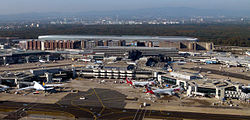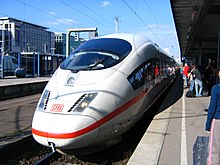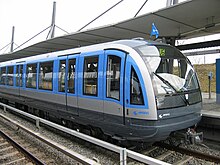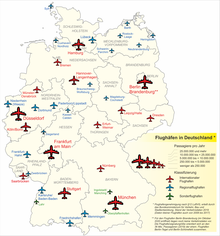Transport in Germany
This article needs additional citations for verification. (August 2016) |


As a densely populated country in a central location in Europe and with a developed economy, Germany has a dense and modern transport infrastructure.
The first highway system to have been built, the extensive German Autobahn network famously has no general speed limit for light vehicles (although posted speed limits are in force in most sections today, and there is a blanket 80 km/h limit for trucks). The country's most important waterway is the river Rhine. The largest port is that of Hamburg. Frankfurt Airport is a major international airport and European transportation hub. Air travel is used for greater distances within Germany but faces competition from the state-owned Deutsche Bahn's rail network. High-speed trains called ICE connect cities for passenger travel with speeds up to 300 km/h. Many German cities have rapid transit systems and public transport is available in most areas. Buses have historically only played a marginal role in long distance passenger service, as all routes directly competing with rail services were in essence outlawed by a law dating to 1935. Only in 2012 was this law changed and thus a long distance bus market has also emerged in Germany since then.
Since German reunification substantial efforts have been necessary to improve and expand the transportation infrastructure in what had previously been East Germany.[1]
Road and automotive transport
Overview

The volume of traffic in Germany, especially goods transportation, is at a very high level due to its central location in Europe. In the past few decades, much of the freight traffic shifted from rail to road, which led the Federal Government to introduce a motor toll for trucks in 2005. Individual road usage increased resulting in a relatively high traffic density to other nations. A further increase of traffic is expected in the future.
High-speed vehicular traffic has a long tradition in Germany given that the first freeway (Autobahn) in the world, the AVUS, and the world's first automobile were developed and built in Germany. Germany possesses one of the most dense road systems of the world. German motorways have no blanket speed limit for light vehicles. However, posted limits are in place on many dangerous or congested stretches as well as where traffic noise or pollution poses a problem.
The German government has had issues with upkeep of the country's autobahn network, having had to revamp the Eastern portion's transport system since the unification of Germany between the German Democratic Republic (East Germany) and the Federal Republic of Germany (West Germany). With that, numerous construction projects have been put on hold in the west, and a vigorous reconstruction has been going on for almost 20 years. However, ever since the European Union formed, an overall streamlining and change of route plans have occurred as faster and more direct links to former Soviet bloc countries now exist and are in the works, with intense co-operation among European countries.
Intercity bus service within Germany fell out of favour as post-war prosperity increased, and became almost extinct when legislation was introduced in the 1980s to protect the national railway. After that market was deregulated in 2012, some 150 new intercity bus lines have been established, leading to a significant shift from rail to bus for long journeys.[2]
Roads

Germany has approximately 650,000 km of roads,[3] of which 231,000 km are non-local roads.[4] The road network is extensively used with nearly 2 trillion kilometers travelled by car in 2005, in comparison to just 70 billion km travelled by rail and 35 billion km travelled by plane.[3]
![]() The Autobahn is the German federal highway system. The official German term is Bundesautobahn (plural Bundesautobahnen, abbreviated BAB), which translates as "federal motorway". Where no local speed limit is posted, the advisory limit (Richtgeschwindigkeit) is 130 km/h. The Autobahn network has a total length of about 12,845 kilometres (7,982 mi) in 2012,[5] which ranks it among the most dense and longest systems in the world. Only federally built controlled-access highways meeting certain construction standards including at least two lanes per direction are called "Bundesautobahn". They have their own, blue-coloured signs and their own numbering system. All Autobahnen are named by using the capital letter A, followed by a blank and a number (for example A 8).
The Autobahn is the German federal highway system. The official German term is Bundesautobahn (plural Bundesautobahnen, abbreviated BAB), which translates as "federal motorway". Where no local speed limit is posted, the advisory limit (Richtgeschwindigkeit) is 130 km/h. The Autobahn network has a total length of about 12,845 kilometres (7,982 mi) in 2012,[5] which ranks it among the most dense and longest systems in the world. Only federally built controlled-access highways meeting certain construction standards including at least two lanes per direction are called "Bundesautobahn". They have their own, blue-coloured signs and their own numbering system. All Autobahnen are named by using the capital letter A, followed by a blank and a number (for example A 8).
The main Autobahnen going all across Germany have single digit numbers. Shorter highways of regional importance have double digit numbers (like A 24, connecting Berlin and Hamburg). Very short stretches built for heavy local traffic (for example ring roads or the A 555 from Cologne to Bonn) usually have three digits, where the first digit depends on the region.
East-west routes are usually even-numbered, north-south routes are usually odd-numbered. The numbers of the north-south Autobahnen increase from west to east; that is to say, the more easterly roads are given higher numbers. Similarly, the east-west routes use increasing numbers from north to south.
The autobahns are considered the safest category of German roads: for example, in 2012, while carrying 31% of all motorized road traffic, they only accounted for 11% of Germany's traffic fatalities.[6]
German autobahns are still toll-free for light vehicles, but on 1 January 2005, a blanket mandatory toll on heavy trucks was introduced.
![]() The national roads in Germany are called Bundesstraßen (federal roads). Their numbers are usually well known to local road users, as they appear (written in black digits on a yellow rectangle with black border) on direction traffic signs and in street maps. A Bundesstraße is often referred to as "B" followed by its number, for example "B1", one of the main east-west routes. More important routes have lower numbers. Odd numbers are usually applied to north-south oriented roads, and even numbers for east-west routes. Bypass routes are referred to with an appended "a" (alternative) or "n" (new alignment), as in "B 56n".
The national roads in Germany are called Bundesstraßen (federal roads). Their numbers are usually well known to local road users, as they appear (written in black digits on a yellow rectangle with black border) on direction traffic signs and in street maps. A Bundesstraße is often referred to as "B" followed by its number, for example "B1", one of the main east-west routes. More important routes have lower numbers. Odd numbers are usually applied to north-south oriented roads, and even numbers for east-west routes. Bypass routes are referred to with an appended "a" (alternative) or "n" (new alignment), as in "B 56n".
Other main public roads are maintained by the Bundesländer (states), called Landesstraße (country road) or Staatsstraße (state road). The numbers of these roads are prefixed with "L", "S" or "St", but are usually not seen on direction signs or written in maps. They appear on the kilometre posts on the roadside. Numbers are unique only within one state.
The Landkreise (districts) and municipalities are in charge of the minor roads and streets within villages, towns and cities. These roads have the number prefix "K" indicating a Kreisstraße.
Rail transport
Overview

Germany features a total of 43,468 km railways, of which at least 19,973 km are electrified (2014).[7]
Deutsche Bahn (German Rail) is the major German railway infrastructure and service operator. Though Deutsche Bahn is a private company, the government still holds all shares and therefore Deutsche Bahn can still be called a state-owned company. Since its reformation under private law in 1994, Deutsche Bahn AG (DB AG) no longer publishes details of the tracks it owns; in addition to the DBAG system there are about 280 privately or locally owned railway companies which own an approximate 3,000 km to 4,000 km of the total tracks and use DB tracks in open access.
Railway subsidies amounted to €17.0 billion in 2014[8] and there are significant differences between the financing of long-distance and short-distance (or local) trains in Germany. While long-distance trains can be run by any railway company, the companies also receive no subsidies from the government. Local trains however are subsidised by the German states, which pay the operating companies to run these trains and indeed in 2013, 59% of the cost of short-distance passenger rail transport was covered by subsidies.[9] This resulted in many private companies offering to run local train services as they can provide cheaper service than the state-owned Deutsche Bahn. Track construction is entirely and track maintenance partly government financed both for long and short range trains.[citation needed] On the other hand, all rail vehicles are charged track access charges by DB Netz which in turn delivers (part of) its profits to the federal budget.
High speed rail started in the early 1990s with the introduction of the Inter City Express (ICE) into revenue service after first plans to modernize the rail system had been drawn up under the government of Willy Brandt. While the high speed network is not as dense as those of France or Spain, ICE or slightly slower (max. speed 200 km/h) Intercity (IC) serve most major cities. Several extensions or upgrades to high speed lines are under construction or planned for the near future, some of them after decades of planning.
The fastest high-speed train operated by Deutsche Bahn, the InterCityExpress or ICE connects major German and neighbouring international centres such as Zurich, Vienna, Copenhagen, Paris, Amsterdam and Brussels. The rail network throughout Germany is extensive and provides excellent service in most areas. On regular lines, at least one train every two hours will call even in the smallest of villages during the day. Nearly all larger metropolitan areas are served by S-Bahn, U-Bahn, Straßenbahn and/or bus networks.
International freight trains
While Germany and most of contiguous Europe use 1,435 mm (4 ft 8+1⁄2 in) standard gauge, differences in signalling, rules and regulations, electrification voltages, etc. create obstacles for freight operations across borders. These obstacles are slowly being overcome, with international (in- and outgoing) and transit (through) traffic being responsible for a large part of the recent uptake in rail freight volume. EU regulations have done much to harmonize standards, making cross border operations easier.
S-Bahn
Almost all major metro areas of Germany have suburban rail systems called S-Bahnen (Schnellbahnen). These usually connect larger agglomerations to their suburbs and often other regional towns, although the Rhein-Ruhr S-Bahn connects several large cities. A S-Bahn doesn't skip stations and runs more frequently then other trains. In Berlin and Hamburg the S-Bahn has an U-Bahn-like service and uses a third rail whereas all other S-Bahn services rely on regular catenary power supply.
Rapid transit (U-Bahn)

Relatively few cities have a full-fledged underground U-Bahn system; S-Bahn (suburban commuter railway) systems are far more common. In some cities the distinction between U-Bahn and S-Bahn systems is blurred, for instance some S-Bahn systems run underground, have frequencies similar to U-Bahn, and form part of the same integrated transport network. A larger number of cities has upgraded their tramways to light rail standards. These systems are called Stadtbahn (not to be confused with S-Bahn), on main line rails.
Cities with U-Bahn systems are:
With the exception of Hamburg, all of those aforementioned cities also have a tram system, often with new lines built to light rail standards.
Cities with Stadtbahn systems can be found in the article Trams in Germany.
Trams (Straßenbahn)
Germany was among the first countries to have electric street - running railways and Berlin has one of the longest tram networks in the world. Many West German cities abandoned their previous tram systems in the 1960s and 1970s while others upgraded them to "Stadtbahn" (~light rail) standard, often including underground sections. In the East, most cities retained or even expanded their tram systems and since reunification a trend towards new tram construction can be observed in most of the country. Today the only major German city without a tram or light rail system is Hamburg. Tram-train systems like the Karlsruhe model first came to prominence in Germany in the early 1990s and are implemented or discussed in several cities, providing coverage far into the rural areas surrounding cities.
Air transport
Short distances and the extensive network of motorways and railways make airplanes uncompetitive for travel within Germany. Only about 1% of all distance travelled was by plane in 2002.[3] But due to a decline in prices with the introduction of low-fares airlines, domestic air travel is becoming more attractive. In 2013 Germany had the fifth largest passenger air market in the world with 105,016,346 passengers.[10] However, the advent of new faster rail lines often leads to cuts in service by the airlines or even total abandonment of routes like Frankfurt-Cologne, Berlin-Hannover or Berlin-Hamburg.
Airlines

Germany's largest airline is former flag carrier Lufthansa that was privatised in the 1990s. The group also includes the regional subsidiaries of Lufthansa Regional as well as the independently operating low-cost subsidiaries Eurowings and Germanwings. Lufthansa operates a dense network of domestic, European and intercontinental routes. Germany's second largest airline is Air Berlin, which also operates a network of domestic and European destinations with focus on leisure routes as well as some long-haul services.
Charter and leisure carriers include Condor, TUIfly, SunExpress Deutschland and Germania. Major German cargo operators are Lufthansa Cargo, European Air Transport Leipzig (which is a subsidiary of DHL) and AeroLogic.
Airports

Frankfurt Airport is Germany's largest airport and a major transportation hub in Europe which ranks among the world's top ten airports. It is one of the airports with the largest number of international destinations served worldwide. Depending on whether total passengers, flights or cargo traffic are used as a measure, it ranks first, second or third in Europe alongside London Heathrow Airport and Paris-Charles de Gaulle Airport. Germany's second biggest international airport is Munich Airport followed by Düsseldorf Airport.
There are several more scheduled passenger airports throughout Germany, mainly serving European metropolitan and leisure destinations. Intercontinental long-haul routes are operated to and from the airports in Frankfurt, Munich, Düsseldorf, Berlin-Tegel, Cologne/Bonn, Hamburg and Stuttgart.
Berlin Brandenburg Airport is expected to become the third largest German airport by annual passengers once it opens, serving as single airport for Berlin. Originally planned to be completed in 2011, the new airport has been delayed several times due to poor construction management and technical difficulties.[11] As of September 2014, it is yet not known when the new airport will become operational.[12]
Airports — with paved runways:
- total: 318
- over 3,047 m: 14
- 2,438 to 3,047 m: 49
- 1,524 to 2,437 m: 60
- 914 to 1,523 m: 70
- under 914 m: 125 (2013 est.)
Airports — with unpaved runways:
- total: 221
- over 3,047 m: 0
- 2,438 to 3,047 m: 0
- 1,524 to 2,437 m: 1
- 914 to 1,523 m: 35
- under 914 m: 185 (2013 est.)
Heliports: 23 (2013 est.)
Water transport
This article needs additional citations for verification. (August 2016) |

Waterways: 7,467 km (2013);[7] major rivers include the Rhine and Elbe; Kiel Canal is an important connection between the Baltic Sea and North Sea and one of the busiest waterways in the world, the Rhine-Main-Danube Canal links Rotterdam on the North Sea with the Black Sea.
Pipelines: crude oil 2,826 km (2013)[13]
Ports and harbours: Berlin, Bonn, Brake, Bremen, Bremerhaven, Cologne, Dortmund, Dresden, Duisburg, Emden, Fürth, Hamburg, Karlsruhe, Kiel, Lübeck, Magdeburg, Mannheim, Nuremberg, Oldenburg, Rostock, Stuttgart, Wilhelmshaven
The port of Hamburg is the largest sea-harbour in Germany and ranks #2 in Europe, #15 worldwide (2015), in total container traffic.[14]
Merchant marine:
total: 427 ships
Ships by type: barge carrier 2, bulk carrier 6, cargo ship 51, chemical tanker 15, container ship 298, Liquified Gas Carrier 6, passenger ship 4, petroleum tanker 10, refrigerated cargo 3, roll-on/roll-off ship 6 (2010 est.)[7]
Ferries operate mostly between mainland Germany and its islands, serving both tourism and freight transport. Car ferries also operate across the Baltic Sea to the Nordic countries, Russia and the Baltic countries.
See also
![]() Driving in Germany travel guide from Wikivoyage
Driving in Germany travel guide from Wikivoyage
![]() Rail travel in Germany travel guide from Wikivoyage
Rail travel in Germany travel guide from Wikivoyage
- List of airports in Germany
- License plates in Germany
- List of motorways in Germany
- List of federal highways in Germany
- Tourism in Germany
- CIA World Factbook - see section on transportation
References
- ^ bundesregierung.de - The federal government says 40% of 164 billion euros spent on transport infrastructure where spent in the eastern part
- ^ http://www.forbes.com/sites/oliverwyman/2015/10/20/european-bus-upstarts-snatch-20-of-passengers-from-rail/2/
- ^ a b c "Transport in Germany". International Transport Statistics Database. iRAP. Archived from the original on March 7, 2009. Retrieved 2009-02-17.
{{cite web}}: Unknown parameter|dead-url=ignored (|url-status=suggested) (help) - ^ "BMVBS - Verkehr und Mobilität-Straße". BMVBS. Retrieved 2011-05-22.
- ^ "Federal Statistic Office". Statistik-portal.de. 1 January 2012. Retrieved 3 September 2012.
- ^ http://www.bast.de (December 2012). "Traffic and Accident Data: Summary Statistics - Germany" (PDF). Bundesanstalt für Straßenwesen (Federal Highway Research Institute). Bundesanstalt für Straßenwesen. Retrieved 2014-04-07.
{{cite web}}: Check date values in:|year=/|date=mismatch (help); External link in|author= - ^ a b c "CIA World Facebook: Germany".
- ^ "German Railway Financing" (PDF). p. 2.
- ^ "Market Analysis: German Railways 2014" (PDF).
- ^ World Bank Datebase, http://data.worldbank.org/indicator/IS.AIR.PSGR
- ^ "New Berlin Airport to Finally Open Next October". Spiegel Online International. 4 September 2012.
- ^ New York Times online article on the delayed Berlin Brandenburg Airport
- ^ https://www.cia.gov/library/publications/the-world-factbook/geos/gm.html
- ^ http://www.worldshipping.org/about-the-industry/global-trade/top-50-world-container-ports
